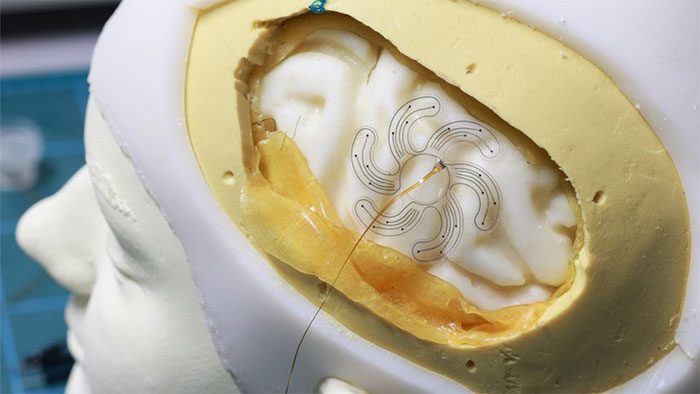Made from silicon polymer and gold fibers, this soft and flexible flower-like electrode can assist neurosurgeons in performing brain surgeries, treating neurological disorders with less invasiveness.
Scientists at the École Polytechnique Fédérale de Lausanne (EPFL) have unveiled a small flexible electrode that can be easily deployed inside the skull, enabling doctors to perform minimally invasive surgeries.
The soft electrode is a device crafted from silicon polymer, a transparent elastic material thin enough to fit into the tight space between the skull and the brain, with the electrode array made of gold. In a recent study, the EPFL team reported successful trials of the soft electrode on laboratory pigs.
The main advantage of this device is that the soft electrode can be inserted into the human brain through a small hole in the skull and then expand inside, allowing neurosurgeons to work on a larger surface area (more neurons and tissue) of the brain. This is how the electrode operates in a unique manner.
What Makes the Electrode Special?
When fully deployed, the electrode features six spiral legs with a diameter that fully expands to 4 cm. However, this does not mean that surgeons need to drill a large 4 cm hole in the skull to place the device.
Before deployment, the electrode resembles a folded rubber piece and is packed inside a cylindrical tube known as a loader. This tube then guides the electrode through a small 2 cm hole in the skull into the cortex. Once the device reaches inside the skull, the pressure-activated spirals will fully expand, allowing the electrode to regain its original shape.
This reverse operation is demonstrated by soft robotics. “The soft robotics community is very interested in this transformation mechanism.” Dr. Sukho Singh, the lead researcher, stated that the advantage of the reverse mechanism is the ability to deploy electrodes of arbitrary sizes with soft compression force applied continuously and minimally on the cortex.
The spiral shape of the electrode is particularly significant in the structure of the soft electrode. The first prototype of the electrode had straight legs, but during testing, the straight soft legs did not distribute the electrode evenly and covered less brain surface.
The electrodes can be deployed for minimally invasive cranial surgeries. (Video EPFL / Alain Herzog)
By utilizing soft spiral legs resembling flower petals, the scientists have overcome these limitations and successfully deployed the electrode in experiments with a small pig. The EPFL team believes that this innovative electrode could lead to more flexible and soft neurosurgical applications, making complex brain surgeries more accessible and minimizing risks.
The Importance of Flexible Electrodes
The electrodes implanted inside the skull are primarily used for Deep Brain Stimulation (DBS). In DBS, electrical currents from an external device are used to stimulate parts of the brain that are not functioning effectively due to disorders ranging from epilepsy to dystonia and Parkinson’s disease.

Electrodes placed on a human brain model. (EPFL / Alain Herzog)
Soft electrodes offer hope for millions of patients worldwide living with neurological conditions. Compared to traditional implants, the new device is less invasive and can be deployed on the cortex more easily and safely.
The flexible structure of the electrode legs allows the device to cover more brain tissue with minimal risk to the skull and brain during DBS. Professor Stéphanie Lacour, a senior author of the study at EPFL, stated: “Minimally invasive neurosurgery technology is essential for providing effective therapies tailored to patients.”
Lacour and her team plan to continue research to upgrade the device into a soft robot and hope to soon test the soft electrode on humans. This new technology opens up many less invasive and highly effective neurological treatment solutions. The research has been published in the journal Science Robotics.



















































